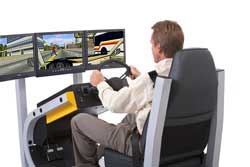The best crisis plan in the world is useless if it sits on a shelf. Your people must be ready to put it into action on a moment’s notice. That takes communication and leadership.
The Chinese philosopher Confucius once said, “I hear and I forget. I see and I remember. I do and I understand.” This ancient proverb seems even more appropriate when dealing with safety and safety training. So many choices are available— including audio, video, written materials, and personal instruction. The Australia-born VoiceMap™ system created by behavioral scientist Maggie Haertsch, Ph.D., combines all of these elements into one to deliver a customized training program that not only instructs trainees, but also gets them actively involved in the lesson.
Safety, productivity, alertness, and quality are tightly linked with job satisfaction. But does this mean state governments should ensure a “living wage”?
Horror stories are the stock-in-trade for Web developers and computer help desk personnel. They are the ones who receive the frantic, middle-of-the-night calls from clients confronted with clawing scrapes and eerie screeches coming from their CPUs, or customers in equal despair wishing their system would make any sound and not just stare at them blankly upon startup, dead.
I’d like to know the true cost of OSHA’s final rule on paying for PPE, which was issued the same day I wrote this column.
In 2004, the U.S. Department of Homeland Security, under presidential order, instituted the National Incident Management System. This nationwide initiative was targeted at getting federal, state, tribal, and local governments to work together to prepare for, prevent, respond to, and recover from domestic incidents, such as terrorist attacks or natural disasters.
Because I’ve lamented regulatory paralysis in Washington, D.C., on many occasions, it’s a relief to cheer a federal safety program that is winning over an industry not by fiat, but by the power of a great idea. The U.S. Coast Guard’s Crew Endurance Management System (CEMS) expects to have 2,000 trained coaches in place by the end of this year and shows no sign of slowing down. What CEMS does is use our scientific knowledge of fatigue to reduce risk factors and boost crew members’ endurance.
The leader of any organization is the safety officer, the head of the organization. Managers and supervisors are safety officers for their respective units and are directly responsible for protecting the resources entrusted to them. Safety must be the core value. However, the predicament is how to effect a value system among individuals—each having his or her own that may already be set in stone. We must realize that not all of our beliefs are the same beliefs others hold. Each of us sees the world differently, and we cannot expect to believe that all will respond the same.

If you don’t know jack about hybrid inertial- acoustic tracking technology, then you probably have not been introduced to Tecnomatix Jack, a human modeling and simulation tool from Siemens PLM Software. Designed to improve the ergonomics of product designs and workplace tasks in virtually any environment, the software features the titular humanoid Jack and his digital cohort, Jill.

Some learn by listening, others by doing. Everyone learns from experience. But when we're learning defensive driving, that experience comes at the cost of increased risk because it requires going out into the real world to practice classroom-taught lessons.
THIS article deals with the subject of health and safety as cultural imperatives in organizations attempting to compete in a global environment; the article will help determine whether your organization has a safety-friendly corporate culture and provides a 10-step model for establishing such a culture.

I am overly attached to my computer mouse--there, I've said it. I cup, grip, push, pull, and otherwise maneuver it merrily all day long, clicking left and right, deftly flinging the cursor, and scrolling with abandon. I keep its pad clean. Sometimes, deep in thought, I think I caress it. I make this confession--providing clearly way too much information--in order to admit at the outset that I have a bias, perhaps even an unhealthy one.
IN case you missed it, the heads of state of Mexico, Canada, and the United States announced the North American Plan for Avian and Pandemic Influenza on Aug. 21, setting in place a much-needed Northern Hemisphere response to prevent a disastrous health episode. The crux of the plan is Chapter 5, Border Monitoring and Control Measures.
OSHA, the International Safety Equipment Association, the National Rifle Association, and roughly 2,000 shooting enthusiasts seemed eager to stop two standards initiatives in mid-July, giving me the odd feeling that what I saw as a lethargic but sensible approach to rulemaking was revolutionary to others. It's a matter of perspective.
I have worked in the field of vision care for more than 34 years. The number one visual complaint over most of those years has been the headaches and eyestrain caused by fluorescent lighting. Somewhere along the line, someone said, "If a little bit of light is good, then a lot of light must be great!" Nothing could be further from the truth. Making the visual system work harder to compensate for the glare is never smarter.

WOULD you like to shift the tide of your maturing workforce from resistant and at risk to involved and secure? The Baby Boom, the birth bulge from 1946 to 1964, is now a Gray(ing) Wave that makes up 40 percent of the U.S. workforce. Many organizations are concerned they will have to pay the costs associated with their aging workers.

FALSE fire alarms are a costly problem. Beyond the financial loss due to downtime, the "cry wolf" factor can affect future response time to critical situations. In the oil industry, the potential for a false reading is especially plausible because of other contributing factors--from radiant sources such as solar radiation, flare reflection from Floating Production Storage and Off-loading (FPSOs) ships, hot CO2 emissions from pipeline pumping stations, and more.
MORE than a handful of PPE manufacturers have been raising alarms about counterfeit safety products for some time now. I never regarded this as much of a threat, I confess, until mid-June of this year, when two simultaneous developments outside our industry convinced me counterfeiting is a serious current problem.